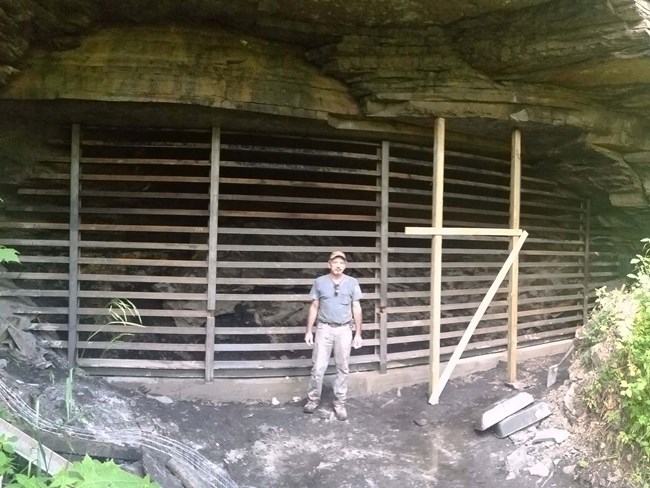Last updated: September 26, 2018
Article
Bat Population Monitoring at New River Gorge National River

NPS photo
Why is the park interested in bats?
Bats are an important part of ecosystems and food webs. Though some species of bats feed on fruit, seeds, or pollen, the species that live in West Virginia are insectivores. They consume huge numbers of insects every night, filling a unique ecosystem role as nocturnal insect predators. Unfortunately, a new disease called white-nose syndrome is affecting bats across the United States. To better protect bats, biologists are studying how local bat populations are changing.
Research Highlights
- Ten species of bats have been documented at New River Gorge, including three federally threatened or endangered species.
- White-nose syndrome has dramatically reduced the populations of some bat species.
- The park helps conserve bats by surveying and protecting critical tree habitats. Gating of mine entrances also protects bats from people and protects people from mines.
Bat species found at New River Gorge National River
Hibernating bats
- Big brown bat (Eptesicus fuscus)*
- Eastern small-footed (Myotis leibii)*
- Indiana bat (Myotis sodalis)*
- Little Brown bat (Myotis lucifugus)*
- Northern long-eared bat (Myotis septentrionalis)*
- Tri-colored bat (Perimyotis subflavus)*
- Virginia big-eared bat (Corynorhinus townsendii)
Migratory bats
- Eastern red bat (Lasiurus borealis)
- Hoary bat (Lasiurus cinereus)
- Silver-haired bat (Lasionycteris noctivagans)
*bat species known to get white-nose syndrome
How do biologists study bats? What have they learned about bats in the park?
Biologists use a variety of techniques to study bats. Special traps (e.g. harp traps) can be used to catch bats at specific sites in the park, such as mine entrances. Biologists can then identify the species and number of bats that are living in a mine. Trapping of bats in the park both before and after white-nose syndrome’s arrival in West Virginia shows a dramatic decline in some species due to the disease.

Biologists have other creative ways of studying these unique animals. Bats use echolocation to navigate and catch insect prey during the night. People can’t hear these bat calls, but biologists use special microphones, called acoustic detectors, to record the sounds. By analyzing the bat calls, biologists can identify which bat species are present in an area.
In all, ten species of bats have been documented in the park. These include the federally endangered Indiana bat (Myotis sodalis), the federally endangered Virginia big-eared bat (Corynorhinus townsendii virginianus), the federally threatened northern long-eared bat (Myotis septentrionalis), and the eastern small-footed bat (Myotis leibii) which is a West Virginia state species of concern (S1).

NPS photo / Jonathan Fiely
What is the park doing to protect bats?
New River Gorge National River works to conserve important bat habitats. During summer seasons, many species of bats live under lose tree bark or in hollow trees. Bats also use these trees as birthing areas for young. In fact, some bats may return to the same tree to roost year after year! In order to identify important tree habitats, biologists survey trees for bats prior to any park management activity that might disturb the area. These surveys help minimize the impact of park activities on bats.
Limiting disturbance at important mines is critical too, so when necessary, the park installs metal gates across mine entrances. To date, 30 mines have been gated. These gates allow bats, but not people, to move in and out of the mine. Despite these efforts, many bat species will continue to struggle. White-nose syndrome is an extraordinarily dangerous threat to bats—sadly, some species may ultimately disappear from the region.
Want to learn more?
For more information:
Contact Biological Science Technician Lenza Paul.
Download a printable pdf of this article.
